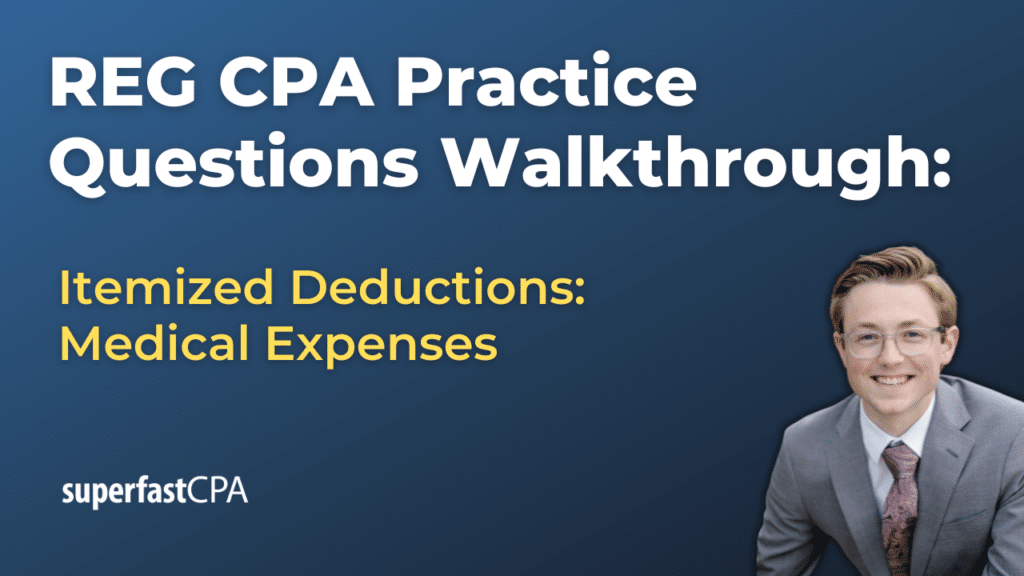In this video, we walk through 5 REG practice questions demonstrating deducting medical expenses as itemized deductions. These questions are from REG content area 4 on the AICPA CPA exam blueprints: Federal Taxation of Individuals.
The best way to use this video is to pause each time we get to a new question in the video, and then make your own attempt at the question before watching us go through it.
Also be sure to watch one of our free webinars on the 6 “key ingredients” to an extremely effective & efficient CPA study process here…
Medical Expenses as Itemized Deductions
Deducting medical expenses as itemized deductions on an individual’s tax return can offer significant tax savings, especially for those with considerable healthcare costs. Here’s a detailed overview:
1. Calculation of Allowable Deduction
- Threshold: Taxpayers can deduct unreimbursed allowable medical and dental expenses that exceed 7.5% of their adjusted gross income (AGI). For instance, if your AGI is $50,000, expenses exceeding $3,750 (7.5% of $50,000) can be deducted.
- Form: To claim this deduction, you must itemize deductions on Schedule A (Form 1040 or 1040-SR).
2. What Counts as a Medical Expense
- General Rule: Expenses are deductible if they are primarily for the prevention or alleviation of a physical or mental defect or illness. This includes payments to doctors, dentists, surgeons, chiropractors, psychiatrists, psychologists, and nontraditional medical practitioners.
- Qualifying Expenses: Some examples include prescription medications, glasses, contacts, hearing aids, wheelchairs, guide dogs, transportation for medical care, surgeries, and home modifications for medical reasons.
- Insurance Premiums: Premiums for medical, dental, and some long-term care insurance can be deducted if they’re not already paid with pre-tax dollars.
- Non-Qualifying Expenses: Costs reimbursed by insurance or other sources, cosmetic surgery not necessary to alleviate or prevent a physical or mental health condition, health club dues, and non-prescribed OTC medications (except insulin) cannot be deducted.
3. Reimbursements and Health Savings Accounts (HSAs)
- Reimbursements: If you’re reimbursed for any expenses, you cannot deduct those amounts. For example, if your insurance covers a portion of your medical bills, only the unreimbursed portion qualifies for the deduction.
- HSAs and FSAs: Contributions to HSAs or Flexible Spending Accounts (FSAs) are made with pre-tax dollars, and withdrawals for qualified medical expenses are not taxed. Therefore, expenses paid with HSA or FSA funds are not deductible.
4. Timing of Payments
The deduction is based on when you actually paid the medical expenses, not when the medical services were provided. You can include expenses on your tax return for the year in which the payment was made, whether by cash, check, or credit card.
5. Who Can You Pay Medical Expenses for?
- Self and Spouse: You can deduct unreimbursed medical expenses you paid for yourself and your spouse.
- Dependents: Expenses for your dependents can also be deducted. This includes anyone you claim as a dependent on your tax return, like your children, and potentially other relatives if they meet IRS requirements for qualification.
- You have to cover more than 50% of support for the dependent.
- They must either be a relative (child, parent, grand parent, sibling) OR they must live with you.
- They must be a US Citizen
Example:
- Taxpayer: Alex
- Adjusted Gross Income (AGI) for the year: $60,000
- Medical Expenses Incurred: Various medical expenses were incurred over the year for Alex, Alex’s spouse Jamie, and their dependent child Casey.
Medical Expenses Details
- Doctor’s visits and treatments (not reimbursed by insurance): $4,500
- Dental expenses for braces (for Casey, not covered by insurance): $5,000
- Prescription medications: $2,000
- Health insurance premiums (paid with post-tax dollars): $6,000
- A medical procedure for Alex performed in December of the previous year, but paid for in the current tax year: $3,000
- Non-prescription, over-the-counter medications: $500 (Note: Generally, these are not deductible unless prescribed)
- Gym membership: $600 (Note: These costs are not deductible as medical expenses)
Calculation of Deductible Medical Expenses
- Total expenses incurred: $4,500 + $5,000 + $2,000 + $6,000 + $3,000 = $20,500
- Non-deductible expenses: $500 (OTC medications) + $600 (gym membership) = $1,100
- AGI Threshold (7.5% of $60,000): $4,500
- Amount exceeding AGI threshold: $20,500 – $4,500 = $16,000













